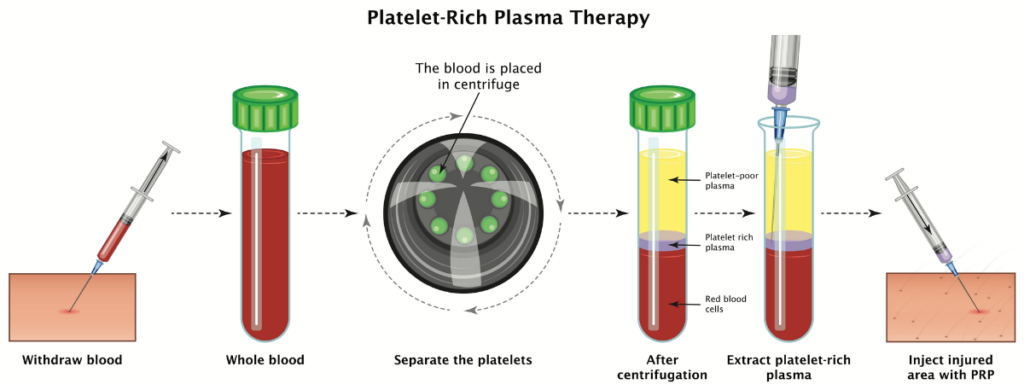What can PRP be used for?
Platelet Rich Plasma (PRP) is a substance promoting regeneration and healing when injected. It is an advanced, cutting-edge therapy utilising growth factors present in the alpha granules’ platelets in an autologous manner.
Plasma is an element of your own blood that encompasses unique “factors,” or proteins, that help your blood to clot. It also contains proteins that support cell growth. Researchers have produced PRP by isolating plasma from blood and concentrating it.
The concept of the PRP treatment is based on the fact that injecting Platelet Rich Plasma into damaged tissues will stimulate your body to grow new, healthy cells and promote healing. Since the tissue growth factors are more concentrated in the prepared growth injections, researchers found the body’s tissues will heal faster.
PRP can be used to treat health conditions:
- Hair loss. Doctors have injected PRP into the scalp to promote hair growth and prevent hair loss. According to research about benefits of the PRP on hair rejuvination, PRP injections effectively treat androgenic alopecia, also known as male pattern baldness.
- Skin regeneration and anti-ageing — according to the study from 2018, Platelets Rich Plasma therapy is a revolutionary treatment to induce cell growth in the skin, which results in retarding and reversing the ageing process.
- Tendon injuries. Tendons are tough, thick bands of tissue that connect muscle to bone. They usually take a long time to heal after an injury. PRP injections are used to treat chronic tendon problems, such as tennis elbow, Achilles tendonitis at the ankle, and jumper’s knee, which causes pain in the patellar tendon in the knee.
- Acute injuries. PRP injections treat acute sports injuries, such as pulled hamstring muscles or knee sprains.
PRP for hair loss
PRP therapy for hair loss is a three-step medical treatment in which a person’s blood is drawn, processed, and then injected into the scalp.
PRP injections trigger natural hair growth and maintain it by increasing blood supply to the hair follicle and increasing the thickness of the hair shaft. Sometimes this approach is combined with other hair loss procedures or medications.
PRP therapy treatment process
PRP therapy is a three-step process. Most PRP therapy requires three treatments 4–5 weeks apart.
Maintenance treatments are required every 4–6 months.
Step 1
Your blood is drawn — typically from your arm — and put into a centrifuge (a machine that spins rapidly to separate fluids of different densities).
Step 2
After about 10 minutes in the centrifuge, your blood will have separated into three layers:
- platelet-poor plasma
- platelet-rich plasma
- red blood cells
Step 3
The PRP is drawn up into a syringe and then injected into areas of the scalp that need increased hair growth.
According to a recent study from 2014, “Although PRP has sufficient theoretical scientific basis to support its use in hair restoration, hair restoration using PRP is still in research phase”
Summary
If you’re concerned about hair loss, you have many options, including medication like Rogaine and Propecia, along with hair transplant surgery. Another consideration is PRP therapy.
Although there is limited clinical evidence on how effective PRP is for hair loss, there is enough proof that PRP is a cost-effective, safe and effective way of reversing hair loss and stimulating new hair growth.
Clinical consultation is essential to determine which treatment or combination of treatments is the best choice for you.

